Pumping Up Pantry StaplesPumping Up Pantry Staples
Retailers can appease New Year’s resolution seekers with fresh, value-added produce and inspiration to eat more healthily.
Exercise more often. Lose weight. Eat more healthily.
The turn of the new year marks a major shift in consumer focus from holiday indulgence to improved lifestyle, with health and nutrition top of mind. As people strip their homes of festive lights and decorations, so too do New Year’s resolution seekers strip their kitchens of calorie-filled casseroles and sinful sweets, turning instead to fresh fruits and vitamin-rich veggies.
For retailers, the new year presents a prime opportunity to boost produce sales by appealing to newly health-conscious consumers who are making changes to their lifestyles. “Make it as simple as possible to assist in the health and wellness journey, which is often coupled with an increased gym regimen that could mean less time or energy for cooking healthy meals,” says Matt Lally, associate director of fresh growth and strategy for New York-based research firm Nielsen.
In the Eye of the Consumer
Precut, ready-to-cook and ready-to-serve produce and salad kits offer a healthy, quick and convenient meal solution to time-strapped shoppers who are incorporating more exercise into their daily routines. In Q3 2017, sales of value-added vegetables increased 7% from the previous year, despite experiencing the lowest weekly dollar sales for its category at $1,888 per store, according to the United Fresh Produce Association’s FreshFacts on Retail Q3 2017 report. With healthy New Year’s resolutions now a consumer focus, retailers have an even greater opportunity to increase sales of already popular value-added produce.
“Placing ready-to-cook and ready-to-serve food on display at eye level to grab attention is important,” says Anne Byerly, VP of marketing for Guadalupe, Calif.-based Apio, which recently introduced a new line of ready-to-cook fresh vegetable side dishes called TimeSavors. The line features three initial products designed to replace common unhealthy dishes: Cauliflower Gratin incorporates cheese sauces and seasoned panko bread crumbs over fresh, roasted cauliflower florets as a substitute for baked macaroni and cheese; Cauliflower Fried Rice offers a lighter alternative to fried rice dishes, featuring cauliflower and broccoli “rice,” diced carrots, celery and an Asian-style sauce; and Green Bean Sauté is an Asian-inspired twist on the classic side dish, including trimmed green beans, spicy Asian sauce and sesame seeds.
These ready-to-eat products satisfy not only the need for convenience, but also the desire for hearty, comfort-style food during the cold, winter months. Potatoes, peppers and onions usually make their way to the top of shoppers’ grocery lists this time of year to be incorporated into cozy, home-cooked recipes. In fact, potatoes, peppers and onions were the top-performing vegetable categories during Q3 2017, according to the FreshFacts report, with potatoes No. 1 at $2,455 weekly dollar sales.
“We notice that root vegetables sales go up during the winter, as people tend to make more comfort foods, soups and stews,” affirms Jonathan Clinthorne, manager of scientific affairs and nutrition education for specialty retailer Natural Grocers by Vitamin Cottage, based in Lakewood, Colo. “While sweet potatoes are always a big seller for us during the winter, in the last couple years we see that consumers are really branching out and buying all the different varieties and colors that sweet potatoes can come in: purple, white and garnet yams are especially popular for us.”
Small Snacks Generate Big Sales
While produce purchases around the holidays tend to feature larger, more visually appealing items for entertaining purposes, smaller, snack-sized fruits and vegetables play a big role in fulfilling healthy New Year’s resolutions. Sales of convenient, grab-and-go produce products also spike during the winter months as consumers turn toward fresh produce to curb their hunger in place of the empty calories found in junk food snacks. “There’s an old saying: ‘You can never exercise away a poor diet,’” says Mac Riggan, director of marketing for fruit grower Chelan Fresh, based in Chelan, Wash. “So if people really want to lose weight, you can’t just be eating what you’ve been eating and exercise hard. You’ve got to eat better. It’s a combination.”
Transforming snacking habits is a major factor in sustaining a healthy diet. The “snackable” fruit and vegetable category is massive and continuously growing, with sales of $16.3 billion in the year ended May 27, 2017, according to Nielsen Fresh. And the on-the-go snacking produce subcategory is a $1.1 billion area, with a compound annual growth rate of more than 10% each year from 2012-2016. To keep up with consumer demand, retailers and manufacturers have introduced 900 new snacking items to grocery stores over that same period, 600 of which were individual servings of fresh-cut fruit, per Nielsen Fresh.
Chelan Fresh specializes in this grab-and-go produce category, offering several snack-sized fruit products, including apple and cherry convenience packs. This year, the company is offering its Rockit apple variety, which naturally grows small, in three-, four- and five-count tubes, as well as in a 3-pound shuttle pack. “We call it the millennial mom’s cookie jar,” says Riggan. Of course, sustaining a healthy diet is as equally important to consumers’ families as it is for their own lifestyles. So often, children return from school and head straight a pantry filled with unhealthy snacks and empty calories, while the healthy choices remain hidden behind the steel door of a refrigerator. “We’re breaking that barrier with this little package so when the kids come home, the Rockit shuttle pack is right on the counter. You just pop the lid and grab one.”
Tomatoes are another common and easily accessible produce snacking option. San Antonio-based Nature Sweet offers several varieties, including its Glorys, Cherubs, Constellation, SunBursts, Jubilees and Eclipses brands. “Consumer demand for fresh, easy, ready-to-use ingredients continues to be on the rise,” says Lori Castillo, marketing director for NatureSweet. “Small-tomato usage also continues to increase as consumers focus more on salads and other healthy, on-the-go products."
Immune to Seasonal Availability
Fulfilling healthy New Year’s resolutions isn’t the only reason consumers seek produce during the first quarter. Citrus sales also rise during the winter season, regardless of seasonal availability. “It’s typically the time of year when people get sick, so they’re going to buy citrus more,” says Riggan. Lemon water, for instance, is known to improve overall wellness, as studies have found the fruit’s high levels of vitamin C can help fight off colds and support the immune system to prevent catching more dangerous illnesses, such as the flu. “You see more citrus available,” Riggan adds. “You see things in the winter that are non-seasonable.”
Despite seasonality, shoppers now expect year-round availability of their favorite crops. According to the Fresh-Facts Q3 2017 report, 81% of households buy citrus annually. It is the only category with more than 30% of its sales occurring during Q1, says Lally of Nielsen, which has resulted in a steady rise in share of annual produce dollars to which the first quarter now contributes, increasing from 24.2% in 2012 to 25.3% in 2016.
“Although some seasonality still exists in produce, it mostly occurs during the spring and summer periods when American crops are ripest,” says Lally. “Consumers have come to expect their favorite produce year-round, so it’s the norm to now see fresh tomatoes or berries in the middle of a Chicago winter.”
Greenhouse growing company Red Sun Farms, based in Kingsville, Ontario, enforces a “Seed to Plate” business approach, operating greenhouse farms in Canada, Mexico and the U.S. to deliver tomatoes, peppers, cucumbers and eggplant to North American consumers any time of year. “Greenhouse vegetables offer year-round flavor and quality,” says Leona Neill, marketing and packaging manager for Red Sun Farms. “This means that consumers no longer have to compromise on their favorite tomatoes, peppers and cucumbers during the long winter months.”
Informing the Consumer
Of course, providing healthy and convenient products is useless without proper execution. Retailers and manufacturers must also educate consumers on the benefits of their products, especially for newly health-conscious New Year’s resolution seekers. “Retailers can do a really good job of putting out information that talks about the benefits of eating fruits and vegetables, how they’re high in nutrients,” says Riggan of Chelan Fresh. “They can really work with in-store RDs to push information out to consumers who are trying to either control blood pressure or diabetes or weight loss.”
But informing consumers on the benefits of eating produce doesn’t end at the store level. To help educate children and inspire healthy eating at a young age, Chelan Fresh has partnered with the NFL and the National Dairy Council for its Fuel to Play 60 program, in which the NFL and National Dairy Council provide information to 11 million kids nationwide on the benefits of playing and exercising for 60 minutes, while Chelan Fresh provides the “fuel” with its apple products. Throughout January, the company’s apple polybags will feature the Fuel to Play 60 logo, directing consumers to its website to learn about how to eat healthy and encourage children to play more often.
About the Author
You May Also Like






